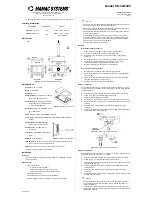
2
15
INSTALLATION AND CONNECTIONS
■
Selecting a location
Select a location for the transceiver that allows ade-
quate air circulation, free from extreme heat, cold, or
vibrations, and away from TV sets, TV antenna ele-
ments, radios and other electromagnetic sources.
The base of the transceiver has adjustable feet for
desktop use. Set the feet to one of two angles, to meet
your operating preference.
■
Grounding
To prevent electrical shock, television interference
(TVI), broadcast interference (BCI) and other prob-
lems, ground the transceiver using the GROUND ter-
minal on the rear panel.
For best results, connect the heaviest possible gauge
wire or strap to a long ground rod. Make the distance
between the [GND] terminal and ground as short as
possible.
R
WARNING! NEVER
connect the [GND] ter-
minal to a gas or electric pipe, since the connection
could cause an explosion or electric shock.
[GND]
■
Antenna connection
For radio communications, the antenna is of criti-
cal importance, along with output power and receiver
sensitivity. Select a well-matched 50
ø
antenna and
coaxial cable feedline. We recommend 1.5:1 or bet-
ter of Voltage Standing Wave Ratio (VSWR) on your
operating bands. The transmission line should be a
coaxial cable.
When using a single antenna, use the [ANT1] con-
nector.
CAUTION:
Protect your transceiver from lightning
by using a lightning arrestor.
Antenna SWR
Each antenna is tuned for a specified frequency
range and the SWR usually increases outside the
range. When the SWR is higher than approx. 2.0:1,
the transceiver automatically reduces the TX power
to protect the final transistors. In that case, an
antenna tuner is useful to match the transceiver and
antenna. Low SWR allows full power for transmit-
ting. The IC-7410 has an SWR meter to continuously
monitor the antenna SWR.
PL-259 CONNECTOR INSTALLATION EXAMPLE
Slide the coupling ring
down. Strip the cable
jacket and tin the shield.
Slide the connector
body on and solder it.
Screw the coupling
ring onto the connec-
tor body.
Strip the cable as
shown at left. Tin the
center conductor.
q
w
e
r
30 mm
10 mm (tin here)
10 mm
1–2 mm
solder solder
tin
Coupling ring
30 mm (1.18 in) 10 mm (0.39 in) 1–2 mm (0.04–0.08 in)
















































